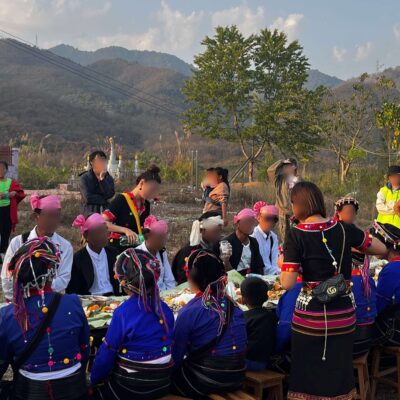Existing understandings of “Global China” in the context of international development and aid are still dominated by the role of the State. This does not fully capture the realities of China’s global engagement in this area.
Chinese Non-Governmental Organisations (NGOs) have become active actors in development cooperation and their participation has been encouraged and has gained more recognition, especially since the launch of China’s Global Development Initiative in 2021—a grand strategy which aims to support the United Nations Sustainable Development Goals. Chinese NGOs, with limited resources, have explored innovative ways to navigate institutional constraints and establish a presence in the global development arena.
From recipient to donor
In recent decades, China’s role in international development has undergone a significant shift, transitioning from a primary recipient of foreign aid to the largest contributor to South-South cooperation. Historically, China’s engagement with global civil society was dominated by the influx of foreign NGOs into the country, rather than outward-oriented activities by domestic Chinese NGOs, but Chinese NGOs have evolved considerably over the past two decades.
The expansion of Chinese NGOs has been closely tied to the nation’s deepening integration into global governance frameworks, including partnerships with international organizations, foreign foundations, and multilateral agencies. During the 1980s, international non-governmental organizations (INGOs)—such as the Ford Foundation, Oxfam, and Save the Children—significantly scaled up their operations in China, introducing funding, technical expertise, and managerial practices. These INGOs played a pivotal role in advancing China’s efforts in poverty alleviation, public health, disaster response, and environmental conservation, while also serving as operational models for domestic NGOs.
Subsequently, NGOs were established by elites within the party-state system. These entities, often termed “government-organized NGOs” (GONGOs), received substantial institutional support from the Chinese government through funding, policy frameworks, and administrative support, such as the provision of staff and offices. Prominent examples include the China Population Welfare Foundation (established in 1987) and the China Foundation for Poverty Alleviation (founded in 1989). Functioning as key actors in China’s governance structure, GONGOs operate extensively across domestic and international spheres. Their mandates align closely with State priorities, focusing on advancing China’s development cooperation objectives through policy implementation and strategic initiatives, both domestically and within global governance frameworks.
A different kind of Chinese NGO proliferated after the Fourth World Conference on Women in Beijing in 1995 when the concept of NGOs as a form of “independent civic organisation” was officially introduced to the Chinese public. These domestic NGOs were often established originally by private individuals to improve certain social problems, such as inequality brought about by economic change over previous decades. They did not have a close relationship with the party-state. Initially, these domestic NGOs focused on implementing aid projects designed by their international counterparts. However, as international NGOs gradually withdrew financial and logistical support, many transitioned into fully domestically funded entities, expanding their mandates to undertake development initiatives both within China and abroad. Notably, a significant proportion were founded by individuals with prior affiliations to international NGOs, leveraging their expertise to bridge global practices with local contexts.
Haihui, an NGO based in Sichuan Province exemplifies this trajectory. Established in 2008 by Chen Taiyong—a former chief representative of US-based Heifer International in China with over two decades of experience—Haihui emerged from a partnership with Heifer, which pioneered poverty alleviation through sustainable livestock provision. Drawing on the adage, “give someone a fish and you feed them for a day; teach someone to fish and you feed them for a lifetime,” Heifer’s model emphasized capacity-building rather than temporary aid. After Heifer ceased funding, Haihui pivoted to collaborate with local governments, aligning its operations with China’s domestic poverty alleviation strategies while retaining elements of international best practice. By 2018, the organization extended its reach internationally, launching what it called the “Belt and Road Initiative (BRI) Charity Park” in Chiang Mai, Thailand, to advance public health, community development, and child welfare programs. This dual competency—rooted in localized implementation and global operational literacy—underscores a broader trend among Chinese NGOs. Their ability to synthesize international expertise with China’s socio-political context has enabled them to navigate both domestic priorities and transnational development agendas effectively.
New policies, new roles
In 2004 China established a legal framework for Chinese NGOs to operate overseas (Regulations on Foundation Administration), marking a pivotal shift in their capacity to engage in international development. Bolstered by this policy, numerous domestic Chinese NGOs began expanding their activities into humanitarian aid and poverty alleviation abroad. However, their efforts were constrained by limited funding and unclear operational protocols as the framework does not provide specific guidelines for NGOs’ participation in international development, reflecting systemic challenges in early-stage transnational civil society engagement.
The 2008 Wenchuan Earthquake proved transformative, accelerating the internationalization of Chinese NGOs. The disaster prompted unprecedented civil society mobilization, enhancing organizational expertise in emergency response, humanitarian coordination, and post-crisis reconstruction. In the aftermath, NGOs such as the China Foundation for Poverty Alleviation and the Amity Foundation extended their operations beyond China, deploying disaster relief projects in South and Southeast Asia. These initiatives not only addressed immediate crises but also exported China’s disaster management model to regional and global contexts.
China’s 2013 Belt and Road Initiative (BRI) and the 2021 Global Development Initiative (GDI) further institutionalized Chinese NGOs as strategic actors in international development. In 2017, the Chinese Government formally recognized NGOs as contributors to public health, education, and poverty reduction along BRI corridors (Action Plan on NGOs to Promote Belt and Road People-to-People Bonds). This policy trajectory culminated in the 2021 revision of China’s Foreign Aid Administrative Measures, which designated NGOs as sanctioned foreign aid organisations, embedding them within the state’s development diplomacy apparatus.
Strategic alignment and competitive positioning
For Chinese NGOs, alignment with state priorities has become a prerequisite for international engagement. Organizations whose expertise intersect with China’s international development strategies—such as green transition, infrastructure, or public health—are better positioned to “go global.” While domestic activities remain their primary focus, international projects increasingly serve as innovative extensions of their core missions. This dual orientation allows NGOs to enhance their competitiveness by demonstrating capacity to mobilize cross-border resources and partnerships. Success in global initiatives not only elevates their standing within domestic rankings but also attracts additional funding and institutional legitimacy.
The emphasis on “green development” under the 2021 Global Development Initiative exemplifies this dynamic. NGOs with expertise in environmental sustainability have capitalized on the policy shift, transitioning into advisory roles for China’s overseas development projects. For instance, Greenovation Hub (GHub), a think tank specializing in climate resilience and carbon neutrality, has emerged as a key partner for Chinese development financiers, government agencies, and private sector stakeholders. By aligning its mission with China’s “green transition” agenda, GHub has secured contracts to advance low-carbon projects abroad.
Funding challenges and innovative approaches
Chinese NGOs continue to grapple with systemic barriers, including restricted funding, regulatory ambiguities, and limited capacity for transnational operations. Consequently, the internationalization of Chinese NGOs remains modest in scale. As of 2021, only 541 out of China’s 901,870 registered NGOs (0.06 percent) were actively engaged in international activities, reflecting slow progress despite formal policy support. It is also important to note that the Chinese government maintains “oversight” of NGOs.
Political recognition remains a critical determinant of operational viability of NGOs, especially smaller ones. While official endorsement does not guarantee financial backing, it confers institutional legitimacy, regulatory safeguards, and opportunities to align with national development agendas. This alignment is particularly vital for organizations seeking to expand beyond domestic borders.
Securing sustainable funding is a pivotal challenge for NGOs aiming to operate internationally. Chinese NGOs typically rely on three primary funding sources for overseas activities:
- Domestic or international foundations (e.g., China Foundation for Poverty Alleviation, Ford Foundation);
- Government agencies or state-owned enterprises (SOEs) involved in foreign aid or Belt and Road Initiative projects;
- Private-sector collaborations, including partnerships with businesses, NGOs, or local communities.
The first two channels have grown increasingly competitive, prompting NGOs to explore other collaborations. Private enterprises, particularly those engaged in BRI and Global Development Initiative projects, face mounting pressure to demonstrate compliance with China’s “people-centered” development principles under the UN Sustainable Development Goals. However, fulfilling corporate social responsibility (CSR) obligations—such as community engagement and social welfare initiatives—often entails significant financial cost. Many domestic NGOs are uniquely positioned to mediate these challenges by providing localized expertise, enabling enterprises to address social needs while enhancing operational efficiency.
For example, an NGO administrator in Guangdong Province (who requested anonymity), recounted the situation of a Chinese company which had invested in textile factories in other developing countries and hired local female workers. However, many companies struggling with low productivity among female workers due to health issues (unrelated to their work). She stated that Chinese NGOs helped the Chinese company design healthcare programs for the local workers, which improved worker well-being and productivity. This could also bolster the enterprise’s reputation as a socially responsible BRI stakeholder and could help the Chinese NGO secure funding from private enterprises (authors’ interview, August 13, 2024).
This case illustrates how NGOs are leveraging private-sector partnerships to address funding gaps while advancing China’s developmental diplomacy. By positioning themselves as intermediaries between corporate interests and local needs, grassroots NGOs carve out innovative roles within transnational governance networks.
Ways forward
The trajectory of Chinese NGOs in international development mirrors China’s broader transformation from a donor recipient to a proactive, strategy-oriented actor in global governance. Initially confined to domestic roles reliant on international partnerships and external funding, Chinese NGOs have begun transitioning toward transnational engagement following pivotal policy reforms. The 2004 Regulations on Foundation Administration marked a critical juncture, enabling experimental forays into cross-border humanitarian aid and development projects. Subsequent initiatives—notably the 2013 Belt and Road Initiative (BRI) and the 2021 Global Development Initiative (GDI)—signaled a strategic shift, formally integrating NGOs into China’s development diplomacy. But despite this institutional recognition, grassroots NGOs continue to grapple with systemic barriers, including unstable funding streams, regulatory ambiguities, and challenges in cultivating durable international partnerships.
While state rhetoric encourages NGO internationalization, the absence of a coherent policy framework undermines operational efficacy. NGOs face persistent difficulties in securing funding and navigating bureaucratic credentialing processes, which remain largely decentralized and opaque. As one NGO funder with extensive international experience (who requested anonymity) noted: “The government advocates for ‘going global,’ but without systematic guidelines or financial safeguards, even basic fundraising becomes precarious. International partners increasingly look to China to fill gaps left by receding Western aid budgets, yet our capacity to respond remains constrained by domestic institutional voids.” (authors’ interview, August 13, 2024)
This paradox underscores a critical tension: NGOs are expected to advance China’s global development ambitions but lack the institutional scaffolding to do so sustainably.
There is a complex interplay between Chinese NGOs, state agendas, private-sector actors, and local communities in partner countries. Despite structural limitations, many Chinese NGOs exhibit remarkable adaptability, leveraging hybrid funding models and aligning with corporate social responsibility initiatives to sustain international operations. Chinese counterparts navigate a distinct paradigm—strategically balancing agency with alignment to secure legitimacy and operational space.
The findings underscore the nascent yet evolving role of grassroots NGOs in China’s international development landscape. While their global footprint remains limited their incremental institutionalization within policy frameworks suggests potential for expanded influence. As China recalibrates its global development priorities, NGOs stand to play a pivotal role in bridging State ambitions with localized implementation. However, realizing this potential hinges on addressing systemic constraints through clearer funding mechanisms, streamlined regulations, and enhanced capacity-building programs. Future research should explore how this distinctive model of state-NGO synergy could reshape global development norms and practices.
Authors: Prof. Chuanhong Zhang and Dongwei Wu.
Further reading:
Image: The opening of the Amity Foundation International Liaison Office. The Amity Foundation is Chinese organization involved in development work in Africa. Credit: Amity Foundation/Flickr.




